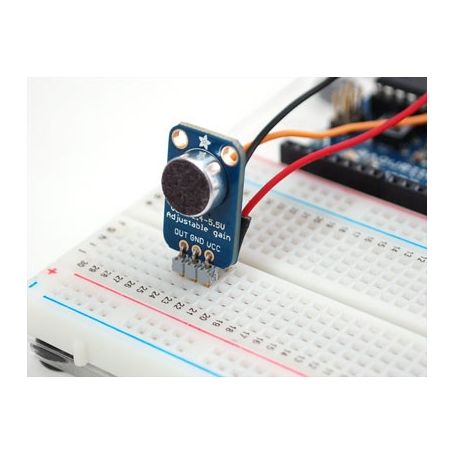[T] - Micro Electret Amplifier - MAX4466 with adjustable gain
Add an ear to your projects with this well-designed electret microphone. Breakout assembled and tested equipped with a 20-20KHz microphone with adjustable gain.
Payments are secured by LyraCollect, a French payment collection company.
It is possible to delivered to your home, to a pick-up point or picked up by appointment at MCHobby
We prepare, pack and ship your orders with great respect and care.
Description
Add an ear to your projects with this electret microphone incorporating an amplifier. This assembled and tested breakout contains an electrect microphone for frequencies of 20-20KHz (soldered to the Breakout).
For signal amplification, the breakout uses a Maxim MAX4466 op-amp specially designed for these delicate tasks! The amplification has excellent noise isolation from the power supply noise rejection circuit. Consequently, the amplification of the sounds is of good quality and the amplified sounds are not "loud" as can be those produced by most of the breakouts available on the market!
Note: The term Vpp used in this description means "Volts Peak to Peak".
The use of this breakout will be perfect for projects like "voice changers", audio recording/sampling and projects responsive to the sound environment (using Fourier transforms, FFT).
The rear of the Breakout contains a small potentiometer which allows you to adjust the gain (amplification). The gain can vary from 25x to 125x. Which amounts to about 200mVpp at the lowest (sound level of a person speaking normally at a distance of 15 cm) which is suitable for connecting a device that awaits an input of type 'line level' without clipping, OR up to approximately 1Vpp, ideal for reading from an Analog/Digital converter (ADC) of a micro-controller.
The output is directly proportional to the sound level ('rail-to-rail Output'), which means that if the sound environment is noisier, the output can reach 5Vpp!
Use
The use is simple:
- connect GND to ground,
- VCC on a supply between 2.4 and 5V continuous (DC). For best results, use the least noisy power supply possible (the term noise should be considered in terms of parasite).
On an Arduino, this should be the 3.3V supply. - OUT: The audio signal comes out from the OUT pin. Le signal audio sort sur la broche OUT.
The output has an average voltage of VCC/2 (DC bias of VCC/2). Consequently, when it is perfectly calm (without noise), the voltage will stabilize at VCC/2 volts (DC coupled).
If your audio equipment requires an "AC coupled" type input, place a capacity of 100µF between the output pin and the input of your audio device.
If you connect to an audio amplifier which has a differential input or which includes the decoupling capacities, the capacity of 100µF isn't necessary.
The audio output pin isn't designed to be connected directly to a loudspeaker (except perhaps the smallest headphones). If you want to use loudspeakers then you will need an audio amplifier (such as our '2 x 3.7w amplifier').
If you plug this breakout into a microcontroller, you don't need an amplifier or decoupling capacity - connect the OUT pin directly to the ADC (Digital Analog Converter) pin of your microcontroller.
For audio-responsive projects, we suggest you to use an FFT library (Fourier transformed) like the one available here because it allows you to accept audio input and 'translate' it into frequencies. You can also take a look at the AdaFruit Voice Changer project which uses this breakout and a Wave Shield.
Tutorials
- Voice Changer - Modify the timbre of the voice (translated into French, on the wiki of MC Hobby, thanks to Mr Carette J. for his participation)
- Voice Changer with Wave Shield (AdaFruit, English)
- See also this nice video presentation of the Voice Changer project
- More information on microphones (including Electrect Microphones) on Wikipedia (French)








